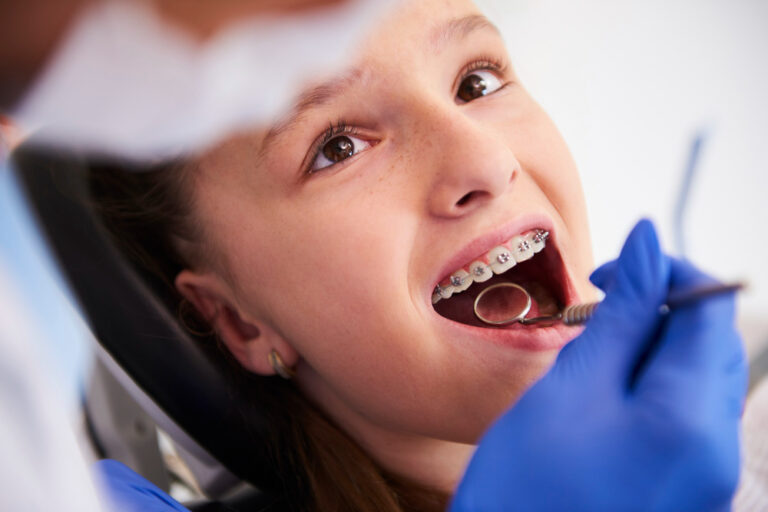Navigating dental care can often feel like a maze of questions and concerns, especially when faced with multiple oral health issues simultaneously. One common question that arises is whether you can still go for braces with cavities. The desire for straighter teeth may clash with the presence of decay, leaving many wondering if orthodontic treatment is even an option. In this blog, we’ll delve into the intricate relationship between cavities and braces, exploring whether it’s feasible to pursue orthodontic correction while addressing teeth cavities.
What is Tooth Cavity?
A cavity, also known as tooth decay, is a part of the tooth’s surface that has become damaged, resulting in small holes or openings (thus the term “cavity”). Cavities develop when bacteria in the mouth generate acid that erodes the tooth enamel, leading to decay. Regular consumption of snacks and sugary beverages, along with poor oral hygiene, are common contributors to the formation of cavities.
Tooth decay can affect individuals of all ages, from young children to older adults. If left untreated, cavities can lead to infection, intense tooth pain, and tooth loss.
Can You Get Braces with Cavities?
Getting braces while you have cavities is generally not advisable unless the braces are only applied to teeth without cavities. For instance, if you have cavities on a few lower teeth but the braces are only needed on the upper teeth, you can proceed with orthodontic treatment.
It is more prudent to address and fill cavities before having braces fitted. This ensures that any weakened teeth are strengthened, increasing the likelihood that your braces will be both successful and comfortable. Additionally, during your orthodontic treatment, you will avoid extra discomfort and reduce the risk of cavities spreading to other teeth.
Can You Get a Cavity Filled with Braces On?
Yes, it is possible to have your cavity filled even with braces on, but it can become a complicated process as compared to filling cavities without braces. In certain cases, your orthodontist might need to remove the brackets and wires from your teeth to reach and treat a cavity. This method can be time-consuming and may necessitate extra appointments to reapply the braces once the dental work is finished. However, a cavity may sometimes be located in a spot accessible enough for your dentist to treat without removing your braces.
If you require dental work while wearing braces, it is crucial to communicate with both your dentist and orthodontist to ensure a smooth process. Your dentist may need to collaborate closely with your orthodontist to coordinate the removal and replacement of the brackets and wires as necessary.
What if You Get Cavities with Braces?
Cavities can manage to find their way in any possible scenario. So, the chances of getting cavities with braces are not impossible, even if you didn’t have any cavities before the orthodontic treatment. Fortunately, there are ways to manage cavities during your braces treatment here’s how:
Maintain Good Oral Habits
Having braces means that you need to be extra careful when brushing and flossing your teeth, as not cleaning properly between the wires and brackets can lead to cavities or other gum diseases. Get a water flosser or interdental brush to gently and deeply clean between spaces your regular brush wouldn’t reach.
Use Fluoride Dental Products
Fluoride-based dental products like mouthwash and toothpaste can help in strengthening your teeth enamel. A healthy enamel means your teeth can fight off decay-causing bacteria that can damage your teeth and cause cavities.
Eliminate Acidic and Sugary Food
Acidic and sugary food can cause the teeth enamel to erode, paving the path for bacteria to attack your teeth and cause cavities. Hence, it’s crucial you eliminate or minimize the intake of such foods to manage cavities with braces on.
Go for Regular Dental Check-ups
Your orthodontist knows best how to treat your teeth during orthodontic treatment. So, never miss your regular dental appointments to better understand your dental status and treat any infections beforehand.
Conclusion
While cavities do not automatically disqualify you from getting braces, addressing any dental issues before starting orthodontic treatment is crucial. Prioritizing the health of your teeth and gums ensures a smoother, more effective process and helps prevent complications during the course of wearing braces. By consulting with your dentist and orthodontist, you can develop a comprehensive plan that includes treating cavities and then proceeding with braces. Ultimately, taking these steps will pave the way for a healthier, more confident smile.
If you are still unsure of whether to get braces with cavities or not, you can visit Vail Orthodontics. Our professionals are skilled in advising patients of their best interests and helping them approach an orthodontic treatment that’s best suited to their needs.
FAQs
Is it possible to get braces with dental fillings?
Yes, it is possible. In fact, most individuals who get braces have at least one filling since cavities are pretty prevalent due to modern sugar-laden diets. Having dental fillings doesn’t prevent you from getting braces because these fillings restore the structure of teeth impacted by cavities.
Before installing braces, your orthodontist will take X-rays to identify the optimal positioning and ensure the treatment plan is appropriate. This process allows them to see any existing fillings before placing the initial braces and wires on your teeth.
Will braces work on teeth that had cavities before?
Yes, braces can be used on teeth that have been properly treated with fillings. It’s important to note that fillings are designed to restore and often enhance the strength of your teeth. These synthetic materials prevent bacteria from causing further cavities in the same spot, as bacteria cannot penetrate the filling material.
Consequently, braces are effective on teeth with previous cavities as long as the fillings are correctly placed. The pressure from the braces generally won’t harm teeth with fillings, even if those teeth have had multiple cavities.

Dr. Patel is an orthodontist and maintains a private practice in Rome, NY. He completed his undergraduate education at the Ohio State University. Then, he earned his Doctorate in Dental Medicine from the University of Pennsylvania School of Dental Medicine in Philadelphia. After earning his doctorate, Dr. Patel attended a three-year, dual-degree residency at Columbia University in New York City. Here, he earned his certificate in Orthodontics and Dentofacial Orthopedics as well as earning a Masters in Oral Biology.


